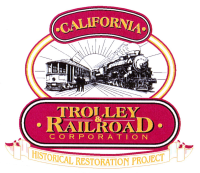SP 2479 Restoration Timeline
Notes: Italic typeface represents organizational milestones. Boldfaced items represent restoration milestones.
1981
The Santa Clara Valley Railroad Association (SCVRRA) is founded by a small group of dedicated volunteers to preserve locomotive 2479.
The initial members were:
- Charles Aldrich
- Larry Ingold
- Mike Kotowski
- Cliff Luscher
- Gene Martin
- Dave Nelson
- Mike Norton.
- Bill Poor
1982
- SCVRRA is incorporated with federal and state tax exempt status and a mission to restore, preserve and operate historic steam-era railroad equipment. Additional supporters are sought through membership offerings.
1983
- The locomotive is inspected to determine its worthiness for running again. During the inspection, the locomotive's whistle, originally thought to be missing, is found underneath several inches of bunker oil in the oil tank. Based upon the inspection, SCVRRA determines to restore the locomotive to operating condition.
1984
- Locomotive and tender are repainted for the annual county fair.
1985-1988
- SCVRRA negotiates with Santa Clara County toward a long term lease to restore and operate locomotive 2479. A key point is the responsibility toward funding the removal of the asbestos lagging.
- During this time, work "parties" are very limited.one day a month (usually the Saturday following the first Monday). Work party attendance typically involves two or three (on busy days) volunteers. Because of concerns toward disturbing the asbestos lagging, restoration work is limited. Any parts that are removed at this time, are stored in the water components of the tender.
1989

- A contract is awarded by the county for asbestos removal.
- May - First container arrives permitting on-site storage of equipment/tools needed for the restoration.
- June - In preparation of asbestos removal, the county provides a small crane which is used by SCVRRA to remove the smoke stack, domes, air pump, air tanks, generator and feed water heater.
- Work parties are now held every Saturday.
- July - Contractor removes asbestos from the locomotive.
- The firebrick is removed from the firebox.
- October - due to the poor quality of its 30 year old display track, the locomotive is listing to one side. This condition is exasperated by the 7.1 "World Series" earthquake. Plans are formalized to move the locomotive.
- December - the contractor returns to remove additional asbestos found in the firebox.
1990
- May - Santa Clara County Supervisor Rod Diridon is elected Chairman of the SCVRRA board.
- Food Machinery Corporation (FMC) donates a 7hp air compressor and misc tools.
- Ultron Labs donates small 12" lathe
- Both air compressor and lathe are installed in the storage container and would later become the workhorses for the project. IBM donates funding to rebuild the compressor.
- November - Due to increasing attendance, monthly meetings are moved to the Santa Clara depot. Prior to this time, meetings were held at various restaurants, offices, and member's homes.
- December 15 - Locomotive is pulled backward off its display track onto new track donated by Southern Pacific Transportation Corporation. (in the rain!)
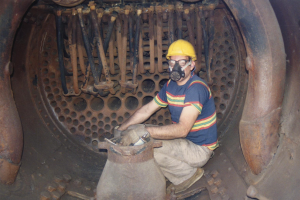
1991
- Second container arrives and becomes the projects shop/tool crib.
- June 15 - Locomotive and tender are separated
- September 28 - Peninsula Crane and Rigging (PCR) provides a 60 ton crane for one day. Disassembled that day were the throttle, cab, oil bunker, and tender trucks. The tender frame is lifted to permit removal of the trucks.
- November 2 - Iron Horse Towing Service lifts both tender trucks to remove wheel sets and journals.
- November 2 - First superheater tube is removed
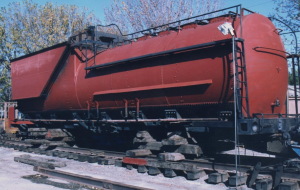
1992
- January 18 - First tender truck wheel sets are taken to the Light Rail maintenance shop for refurbishing.
- February 22 - Last of the boiler tubes is removed.
- May 23 - Donated by the Central Fire District, a 20'x40' mobile home is moved to the fairgrounds and would provide administrative space for the project.
- Oil Bunker is reconditioned inside and out
- Tender tank exterior is needle scaled.
- Interior of Boiler is cleaned.
1993
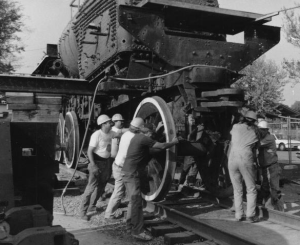
- Non-destructive Testing (NDT) is performed on the boiler as a class project by Contra Costa (Community) College.
- A third storage container is acquired and is used for storage of refurbished parts.
- February 20 - Tender tank is lifted by PCR from the tender frame.
- Tender Frame is sandblasted and painted
- New baffle plates are installed within the tender tank
- Locomotive cab is moved to Borch's Iron Works for sheet metal work
- October 3 - Donated by members Denis and Patti Murchison, SP bay window caboose #1589 arrives at the fairgrounds
- Locomotive lift preparation
- Removal of running gear: side, connecting and valve gear rods
- Relaying of track
- Removal of brake rigging
- Obtaining lifting beams, jacks and cribbing from Golden Gate Railroad Museum
- Refurbishing lifting jacks
- October 30 and 31 - the 73" Drivers and both lead and trailing truck assemblies are rolled from underneath the locomotive.
1994
- Drivers are moved to Westinghouse in Sunnyvale.
- February - Robert Franzen, motive power superintendent of the Grand Canyon Rwy, visits over a weekend to provide advice.
- February - In writing, Southern Pacific Railroad donates to Santa Clara County the six stall roundhouse and turntable to the railroad museum project.
- 12" lathe, originally donated in 1990, is put to work by project machinist Fred Parkin.
- Large forklift is donated by Ralph Domenici.
- Tender tank exterior is sandblasted and painted
- Drivers are sandblasted and NDT'd at Westinghouse.
- Tender truck bolster is refurbished at Oakland Machine Works
- Landlocked in LaSelva Beach, two AT&SF cupola cabooses, #999073 and #999294, are acquired and loaded in Watsonville onto flatcars.
- November - Two Harriman passenger cars(1927 Standard Steel ex-SP #2155 and 1924 Pullman ex SP #2085) are acquired and moved to the family park area of the fairgrounds.
- November 7 - An organizational merger with the San Jose Trolley Corporation is completed. The new organization is to be called the California Trolley and Railroad Corporation. (CTRC).
- December 11 - The tender frame draw bar hole is bored out using a portable boring unit provided by Western Steel Cutters and arranged by Don Michelleti of the Golden Gate Railroad Museum. (In the rain)
1995
- Tender trucks are reassembled and reinstalled underneath the tender frame.
- CTRC website is created
- Tender tank and frame are painted.
1996
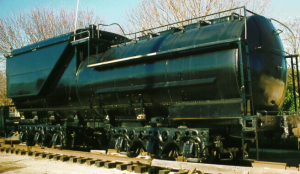
- January 27 - PCR returns to the site and installs tender tank back onto the frame. Additionally, the oil bunker is returned to the tender tank.
- Removal of the fire pan to permit access to the firebox
- Lead and trailing trucks are disassembled and their wheels sets are sent to light rail.
- CTRC volunteers remove 1700 ft of track off the 4th street line. This labor intensive effort spans over several months.
- To replace the missing set, Jim Holmes donates a complete set of locomotive gauges to the project.
1997
- Running boards are removed and repaired
- Needle scaling of locomotive frame
- Reinstallation of tender brake rigging.
- Machinist Fred Parkin begins custom making all 210 boiler studs.
- Donated by Rick Griffith, a wide cupola Missouri Pacific caboose is moved by rail to storage in Salinas (where it remains today.)
- Built in 1941 and numbered 881-002, a 70 ton General Electric diesel locomotive is donated to CTRC by Kaiser Permanente Cement. This operable locomotive remains stored at the cement facility west of Cupertino.
- A complete set of new locomotive (lead, driver and trailing truck) springs are ordered and received.
- Generator and feedwater heater are sent to Backshop Services (Colorado) for refurbishment.
- An in-depth boiler repair specification is released to nine potential bidders. Only two respond.
1998
- The selected contractor, Manley Boiler Company, performs repair work on the firebox and boiler. The work includes:
- Removal, forming, and reinstallation of the both lower side sheets and the throat sheet within the firebox.
- Installation of a patch in the crown sheet
- Reinstallation of the rigid and flexible staybolts affected by the firebox sheet repairs.
- Completed repairs in the tube sheet.
- Safety valves, mechanical lubricator, and injector are sent to Backshop Services for refurbishing.
- The smoke stack casting is repaired by CMB Industries (Fresno).
- Locomotive spring rigging is removed.
- July - Drivers are moved from Westinghouse to Light Rail Maintenance facility to allow grinding out the NDT identified cracking.
- A large milling machine is donated by Borch Iron works and moved to the trolley barn.
- Trailing truck frame is repaired at Oakland Machine Works.
- Drivers are moved from light rail to Oakland Machine works to permit welding of crack locations.
1999
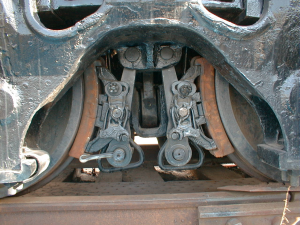
- Flues and tubes are reinstalled by Manley Boiler Company
- New cab flooring is installed.
- Reboring and rebushing of locomotive spring equalizers.
- CTRC provides a booth and operates the horsecar for Railfair '99 at the California State Railroad Museum in Sacramento.
- Feedwater Heater is rebuilt by Backshop Services.
- December 22 - from Bill Hewlett's personal estate, a Bridgeport mill and Hardiage lathe are moved to the fairgrounds and installed in container #2.
2000
- Drivers are returned to the fairgrounds from Oakland Machine Works. It is determined that CTRC must contract out the remaining required repair work.
- Steam Operations Services (Scott Lindsay) provides a formal evaluation of the remaining work
- Beginning June 19th, the San Jose Roundhouse and turntable are disassembled and relocated to the family park section of the fairgrounds. This work is done by October.
- Trailing truck is reassembled.
- December - To support fairgrounds development, Santa Clara County mandates that the locomotive and all equipment be moved to the family park by April of the next year.
2001
- Mobile home, three containers (and their contents) two forklifts etc etc are moved by CTRC before the April 1st deadline.
- March - with support from Industrial Rail, the tender and caboose #1589 are moved the ½ mile to the family park over temporary panel track (in the rain!)
- April 5 - under CTRC contract, the locomotive (without wheels) is moved by Kelley Brothers Movers.
- New site requires power, air lines, and general organization before restarting restoration process.
- **Several large machine tools (two lathes, shaper, hydraulic press) are donated by Reg Holloway and moved to the fairgrounds. An outdoor machine shop is created on-site.((
- Actual locomotive restoration work resumes in the Fall.
2002
- On-site machine of pins and bushings for the spring rigging.
- Repair of the locomotive spring hangers.
- Superheater tubes are individually tested and rebanded.
- Lead truck journal boxes are repaired onsite using recently donated shaper.
- Exhaust nozzle and base (located in the smokebox) are repaired.
- June 25 - The Santa Clara County Board of Supervisors votes to rescind support of a fairgrounds railroad museum.
- An RFP for the required driver and journal box work is released. Three bidders visit the restoration site and provide proposal. Steam Services of America (Robert Franzen) is selected for the contract.
2003
- Group focus on lead truck components
- Lead truck is reassembled/disassembled to make adjustments
- New centering wear plate is machined at trolley barn
- July 9 - the drivers and journal box work are loaded for shipment to Steam Services of America. Contracted work includes:
- Drivers
- Repair cracks (in any)
- Replace one tire
- Reprofile all tires
- New hub liners
- Quarter crank pins
- Polish hubs, crank pins and axles
- Journal Boxes
- New hub liners
- New crown brasses
- Replace all shoes and wedges
- Frame Tramming
- Locomotive Frame is trammed
2004
- Lead truck is reassembled.
- January 10 - the last locomotive frame hole for the spring equalizing rigging is bored. Reassembly of the locomotive's spring rigging begins.
- Former Southern Pacific 0-6-0 steam locomotive #1215 is acquired from the Feather River Rail Society and remains stored at the Portola Railroad Museum.
- Refurbishment of the locomotive brake foundation begins.
- July 28 - Driving wheels and journal boxes return from Arizona
- Spring Equalizing system is reinstalled.
- After extensive crack repair, the smoke stack is repositioned back in place.
- In accordance with recently revised federal regulations for steam locomotives, a detailed boiler survey is begun.
2005
- Tramming of the locomotive frame commences.
- Power reverse assembly is repaired.
- Shoes and wedges are fitted to the locomotive frame.
- August 20 - Pistons are removed from the cylinders.
- Tramming measurements taken by special Wheelygig tool, on loan from the Golden Gate Railroad Museum.
- New bushings and pins machined on-site for brake rigging.
- 60 flexible staybolts are replaced.
- December - Samax Inc. donates a 10 inch shaper machine tool to the project.
2006
- Repair work begins on driver journal frame pedestals - Large crackes are subsequently identified behind wear plates.
- All repair work on brake rigging is completed (143 components).
- 80 staybolts replaced in firebox.
- April - Misc items removed off SP1215 in Portola in advance of asbestoes abatement.
2007
- January - Asbestoes abatement performed on SP1215 in Portola.
- Replace hydraulic cylinder in heavy duty Clark forklift.
- Driver pedestals are repaired and wear plates installed.
- Spring hanger saddles are machined
- October 16 - SP1215 arrives at History San Jose after transport from Portola.
2008
- February - The California State Railroad Museum donates Santa Fe Railroad 0-4-0 steam locomotive "Little Buttercup" to CTRC.
- New Steps are installed on SP1215 - the first restoration activity on this artifact.
- SP2479
- Repair of front coupler pocket.
- Locomotive is re-cribbed to permit rewheeling
- Locomotive is re-cribbed to permit rewheeling
- Side Sheets and Mud Ring are caulked
- August - December At the request of the fairgrounds, CTRC begins to vacate current location and consolidate all materials and equipment to the western edge of parcel. Items moved include:
- San Jose Roundhouse components
- Three shop containers *Outdoor shop canopy and large machine tools
- 2479's Tender
- SP Bay Window Caboose #1589
- September 3 A certified welder from Bay City Boiler completes repairs on unstayed area on 2479's boiler.
- SP1215 is repositioned at its History San Jose display location.
- October 25-28 - After 15 years, 2479's lead truck, trailing truck and 73" drivers are returned underneath the locomotive. Several days are spent lowering the locomotive to ensure proper component alignment.
2009
- January - Using several sections of snap track, locomotive 2479 is rolled on its wheels several hundred feet to a new restoration location at the fairgrounds. This move also involves a 90 degree rotation of the locomotive for alignment with other railroad equipment.
